Comprehensive Business Environment Analysis of Marks & Spencers
VerifiedAdded on 2024/06/11
|18
|4173
|94
Report
AI Summary
This report provides a comprehensive analysis of the business environment affecting Marks and Spencers (M&S), a prominent retail organization based in London. It begins with an overview of different types of organizations—private (T J Morris), public (TeachFirst), and voluntary (Cancer Research UK)—and their respective roles in the economy. The report details the background, products, services, size, scope, vision, mission, business objectives, organizational structure, and stakeholders of selected organizations, including M&S. It explains the functions within M&S, such as marketing and sales, design and operation, research and development, finance, human resources, and customer service, illustrating their interrelation through an organizational chart. A PESTLE analysis identifies and discusses macro-environmental factors impacting M&S, including political (Brexit, EU regulations), economic (inflation, consumer confidence), social (ethical consumerism, health trends), technological (e-commerce, automation), legal (employment laws, data protection), and environmental (sustainability, waste management) aspects. Furthermore, the report conducts internal and external analyses to pinpoint strengths and weaknesses and applies a SWOT analysis to highlight key strategic considerations for M&S. The analysis emphasizes how these factors influence the decision-making process within the organization, providing valuable insights into navigating the complexities of the business environment.
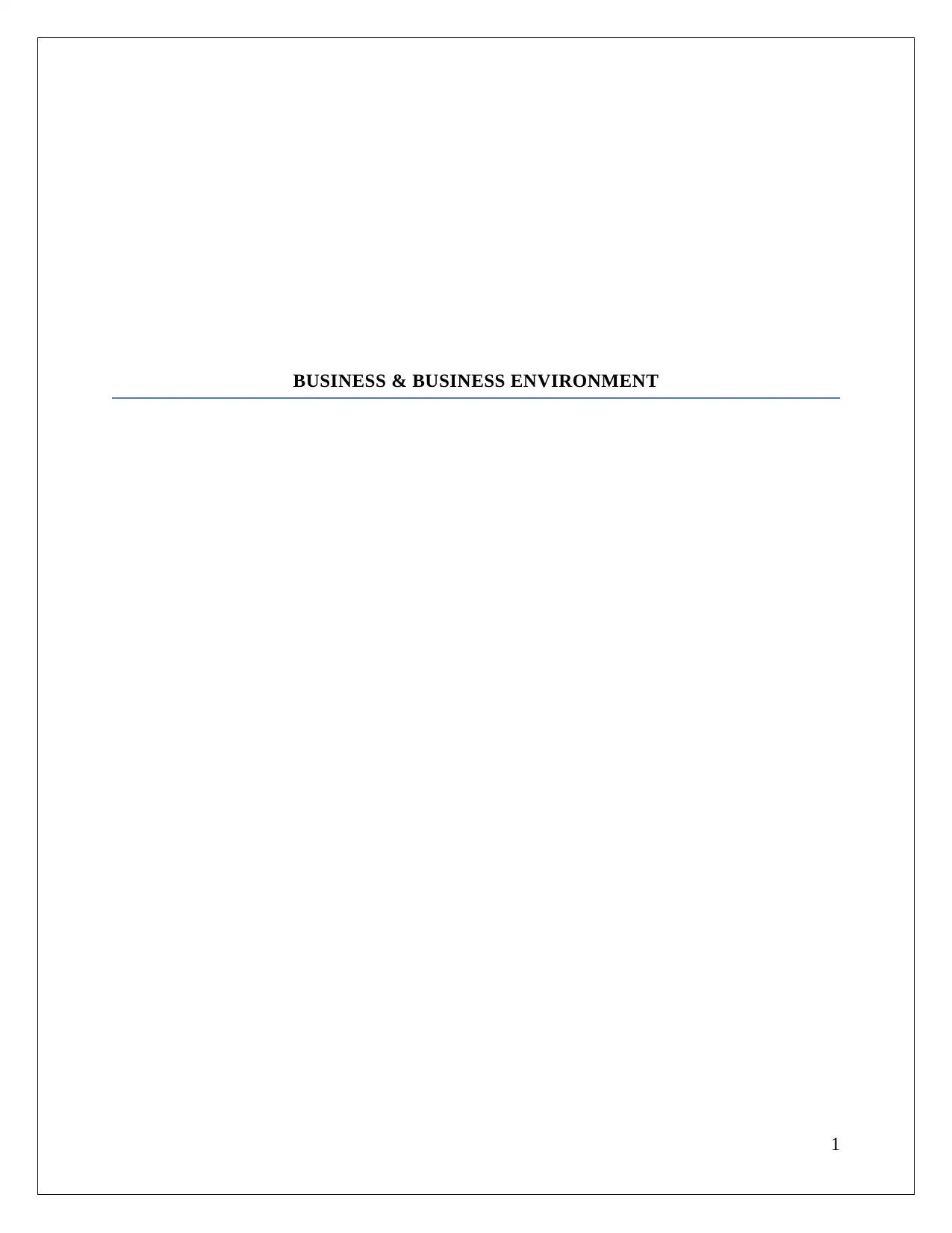
BUSINESS & BUSINESS ENVIRONMENT
1
1
Paraphrase This Document
Need a fresh take? Get an instant paraphrase of this document with our AI Paraphraser

Table of Contents
Introduction......................................................................................................................................3
1. Introduction to provide an overview, with an explanation of different types of organizations
and the growth of the international business environment.(P1, M1)...............................................4
2 An explanation of each of the chosen organizations, including: background details of the
organization, the products and services they supply; the size and scope of the organization; their
vision, mission and business objectives; the organizational and legal structure; and information
about their stakeholders...................................................................................................................6
3 In detail, explain the functions for one of the chosen organisations, using an organisation chart
to show how the functions interrelate and an explanation of how they link to the organisational
objectives and structure...................................................................................................................8
4 Using PESTLE analysis, identify and discuss the various macro environmental factors that
impact on the business operations, highlighting the positive and negative impacts with specific
examples relating to your chosen organization.............................................................................10
5 Conduct the internal and external analysis for the chosen organization in order to identify the
strengths and weakness. Explain how they influence the decision-making process.....................12
6. Apply a SWOT or TOWS analysis to your organisation to identify their key strengths and
weaknesses. Explain the interrelationships these have with the external macro factors previously
discussed........................................................................................................................................14
Conclusion.....................................................................................................................................15
Reference List................................................................................................................................16
2
Introduction......................................................................................................................................3
1. Introduction to provide an overview, with an explanation of different types of organizations
and the growth of the international business environment.(P1, M1)...............................................4
2 An explanation of each of the chosen organizations, including: background details of the
organization, the products and services they supply; the size and scope of the organization; their
vision, mission and business objectives; the organizational and legal structure; and information
about their stakeholders...................................................................................................................6
3 In detail, explain the functions for one of the chosen organisations, using an organisation chart
to show how the functions interrelate and an explanation of how they link to the organisational
objectives and structure...................................................................................................................8
4 Using PESTLE analysis, identify and discuss the various macro environmental factors that
impact on the business operations, highlighting the positive and negative impacts with specific
examples relating to your chosen organization.............................................................................10
5 Conduct the internal and external analysis for the chosen organization in order to identify the
strengths and weakness. Explain how they influence the decision-making process.....................12
6. Apply a SWOT or TOWS analysis to your organisation to identify their key strengths and
weaknesses. Explain the interrelationships these have with the external macro factors previously
discussed........................................................................................................................................14
Conclusion.....................................................................................................................................15
Reference List................................................................................................................................16
2
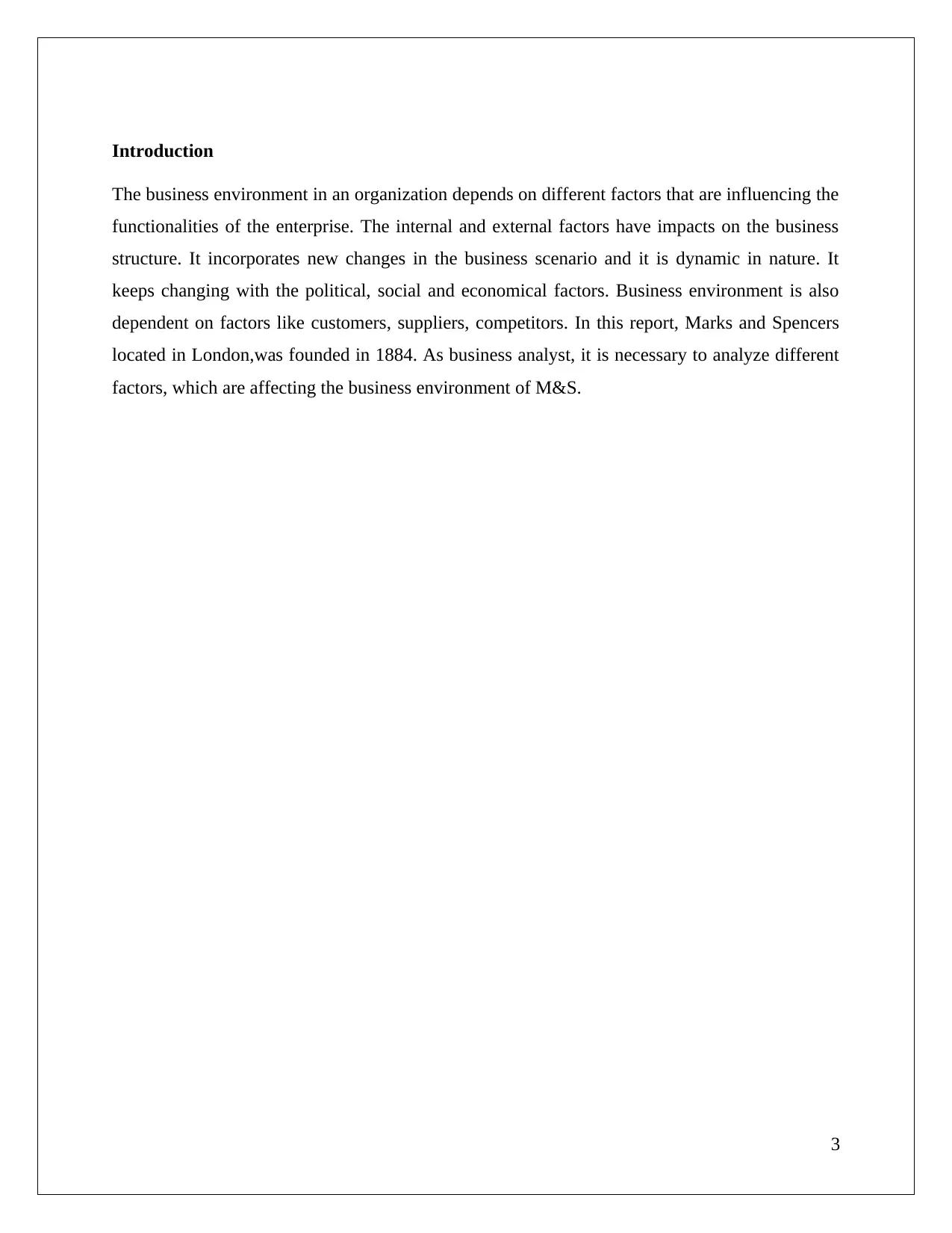
Introduction
The business environment in an organization depends on different factors that are influencing the
functionalities of the enterprise. The internal and external factors have impacts on the business
structure. It incorporates new changes in the business scenario and it is dynamic in nature. It
keeps changing with the political, social and economical factors. Business environment is also
dependent on factors like customers, suppliers, competitors. In this report, Marks and Spencers
located in London,was founded in 1884. As business analyst, it is necessary to analyze different
factors, which are affecting the business environment of M&S.
3
The business environment in an organization depends on different factors that are influencing the
functionalities of the enterprise. The internal and external factors have impacts on the business
structure. It incorporates new changes in the business scenario and it is dynamic in nature. It
keeps changing with the political, social and economical factors. Business environment is also
dependent on factors like customers, suppliers, competitors. In this report, Marks and Spencers
located in London,was founded in 1884. As business analyst, it is necessary to analyze different
factors, which are affecting the business environment of M&S.
3
⊘ This is a preview!⊘
Do you want full access?
Subscribe today to unlock all pages.

Trusted by 1+ million students worldwide
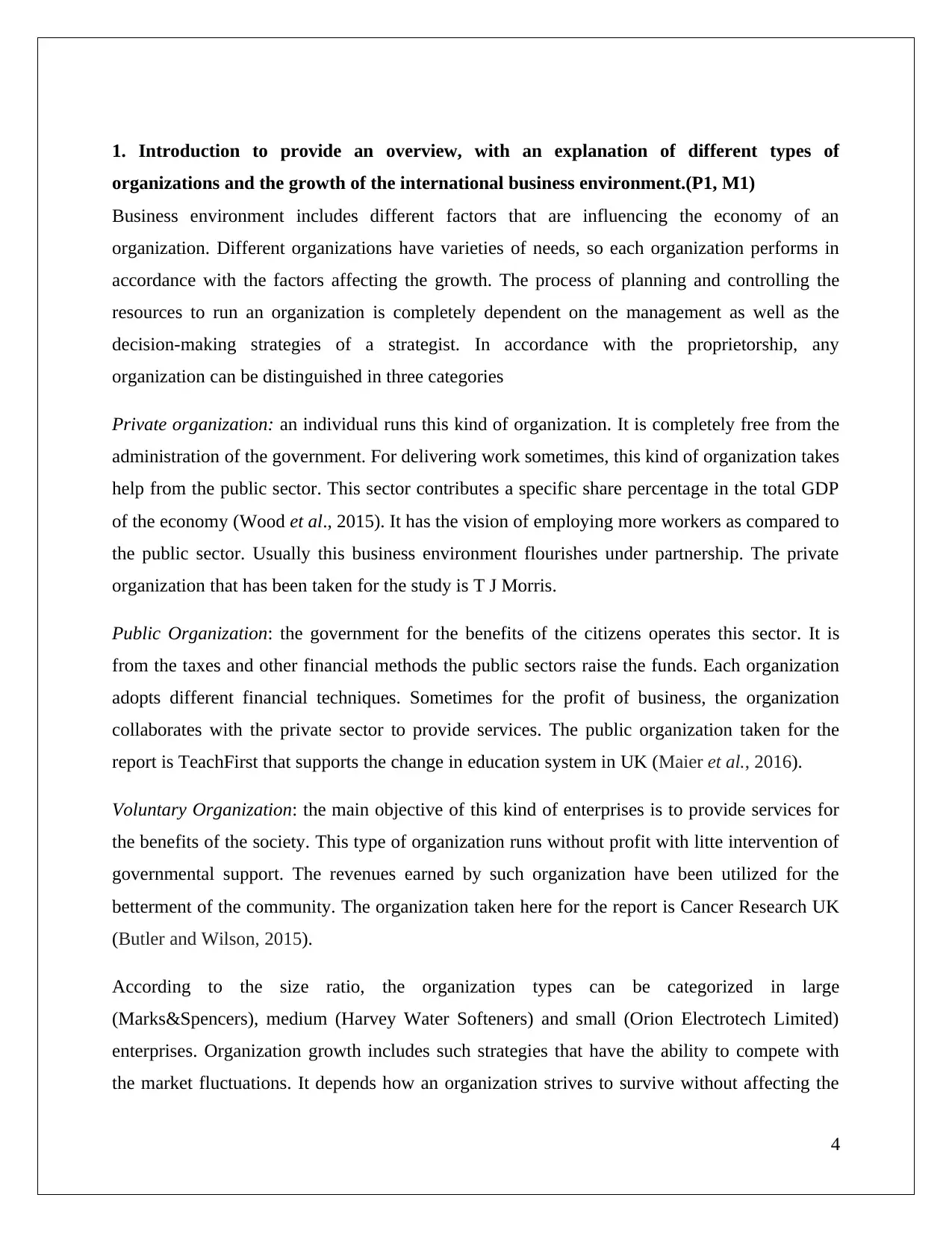
1. Introduction to provide an overview, with an explanation of different types of
organizations and the growth of the international business environment.(P1, M1)
Business environment includes different factors that are influencing the economy of an
organization. Different organizations have varieties of needs, so each organization performs in
accordance with the factors affecting the growth. The process of planning and controlling the
resources to run an organization is completely dependent on the management as well as the
decision-making strategies of a strategist. In accordance with the proprietorship, any
organization can be distinguished in three categories
Private organization: an individual runs this kind of organization. It is completely free from the
administration of the government. For delivering work sometimes, this kind of organization takes
help from the public sector. This sector contributes a specific share percentage in the total GDP
of the economy (Wood et al., 2015). It has the vision of employing more workers as compared to
the public sector. Usually this business environment flourishes under partnership. The private
organization that has been taken for the study is T J Morris.
Public Organization: the government for the benefits of the citizens operates this sector. It is
from the taxes and other financial methods the public sectors raise the funds. Each organization
adopts different financial techniques. Sometimes for the profit of business, the organization
collaborates with the private sector to provide services. The public organization taken for the
report is TeachFirst that supports the change in education system in UK (Maier et al., 2016).
Voluntary Organization: the main objective of this kind of enterprises is to provide services for
the benefits of the society. This type of organization runs without profit with litte intervention of
governmental support. The revenues earned by such organization have been utilized for the
betterment of the community. The organization taken here for the report is Cancer Research UK
(Butler and Wilson, 2015).
According to the size ratio, the organization types can be categorized in large
(Marks&Spencers), medium (Harvey Water Softeners) and small (Orion Electrotech Limited)
enterprises. Organization growth includes such strategies that have the ability to compete with
the market fluctuations. It depends how an organization strives to survive without affecting the
4
organizations and the growth of the international business environment.(P1, M1)
Business environment includes different factors that are influencing the economy of an
organization. Different organizations have varieties of needs, so each organization performs in
accordance with the factors affecting the growth. The process of planning and controlling the
resources to run an organization is completely dependent on the management as well as the
decision-making strategies of a strategist. In accordance with the proprietorship, any
organization can be distinguished in three categories
Private organization: an individual runs this kind of organization. It is completely free from the
administration of the government. For delivering work sometimes, this kind of organization takes
help from the public sector. This sector contributes a specific share percentage in the total GDP
of the economy (Wood et al., 2015). It has the vision of employing more workers as compared to
the public sector. Usually this business environment flourishes under partnership. The private
organization that has been taken for the study is T J Morris.
Public Organization: the government for the benefits of the citizens operates this sector. It is
from the taxes and other financial methods the public sectors raise the funds. Each organization
adopts different financial techniques. Sometimes for the profit of business, the organization
collaborates with the private sector to provide services. The public organization taken for the
report is TeachFirst that supports the change in education system in UK (Maier et al., 2016).
Voluntary Organization: the main objective of this kind of enterprises is to provide services for
the benefits of the society. This type of organization runs without profit with litte intervention of
governmental support. The revenues earned by such organization have been utilized for the
betterment of the community. The organization taken here for the report is Cancer Research UK
(Butler and Wilson, 2015).
According to the size ratio, the organization types can be categorized in large
(Marks&Spencers), medium (Harvey Water Softeners) and small (Orion Electrotech Limited)
enterprises. Organization growth includes such strategies that have the ability to compete with
the market fluctuations. It depends how an organization strives to survive without affecting the
4
Paraphrase This Document
Need a fresh take? Get an instant paraphrase of this document with our AI Paraphraser
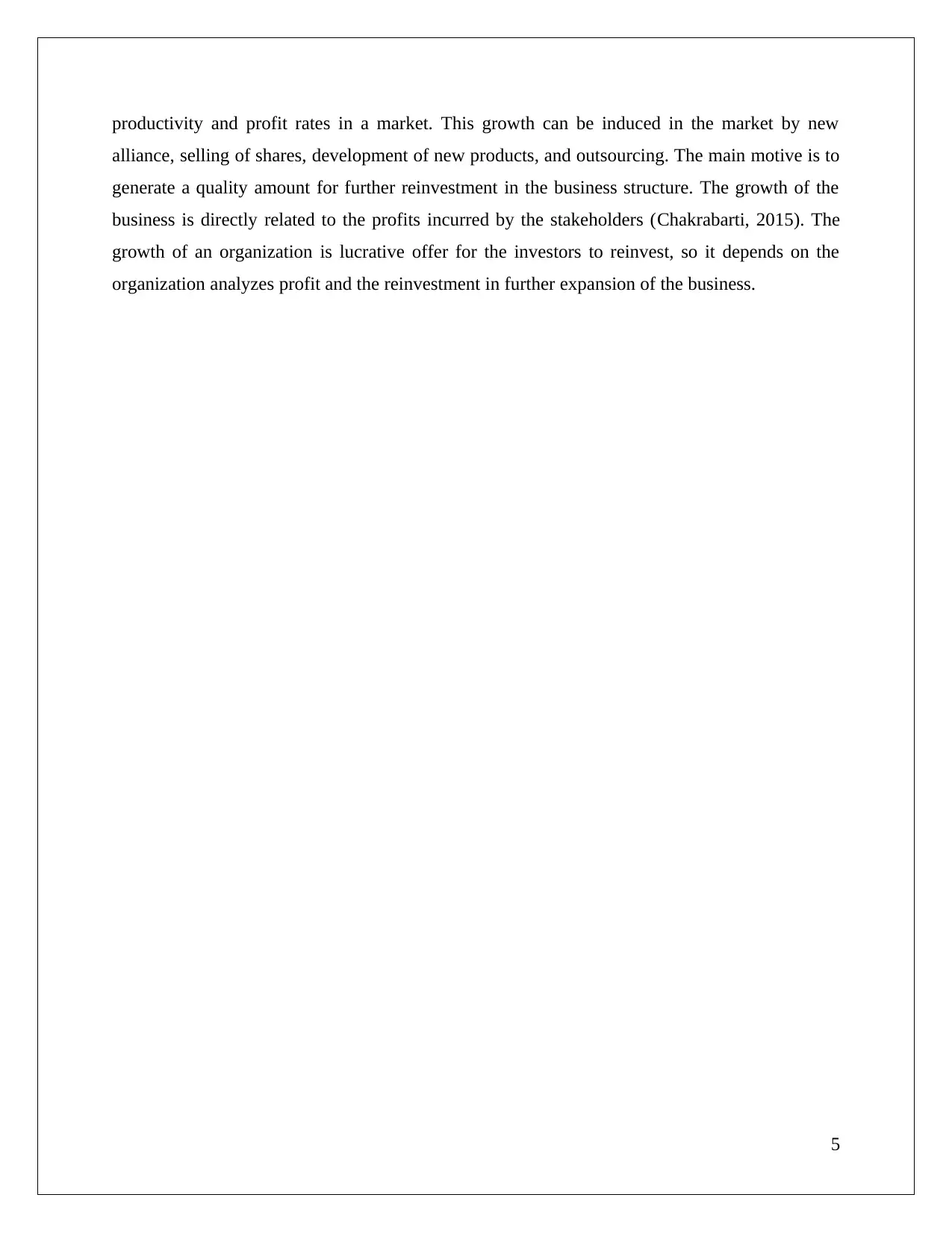
productivity and profit rates in a market. This growth can be induced in the market by new
alliance, selling of shares, development of new products, and outsourcing. The main motive is to
generate a quality amount for further reinvestment in the business structure. The growth of the
business is directly related to the profits incurred by the stakeholders (Chakrabarti, 2015). The
growth of an organization is lucrative offer for the investors to reinvest, so it depends on the
organization analyzes profit and the reinvestment in further expansion of the business.
5
alliance, selling of shares, development of new products, and outsourcing. The main motive is to
generate a quality amount for further reinvestment in the business structure. The growth of the
business is directly related to the profits incurred by the stakeholders (Chakrabarti, 2015). The
growth of an organization is lucrative offer for the investors to reinvest, so it depends on the
organization analyzes profit and the reinvestment in further expansion of the business.
5
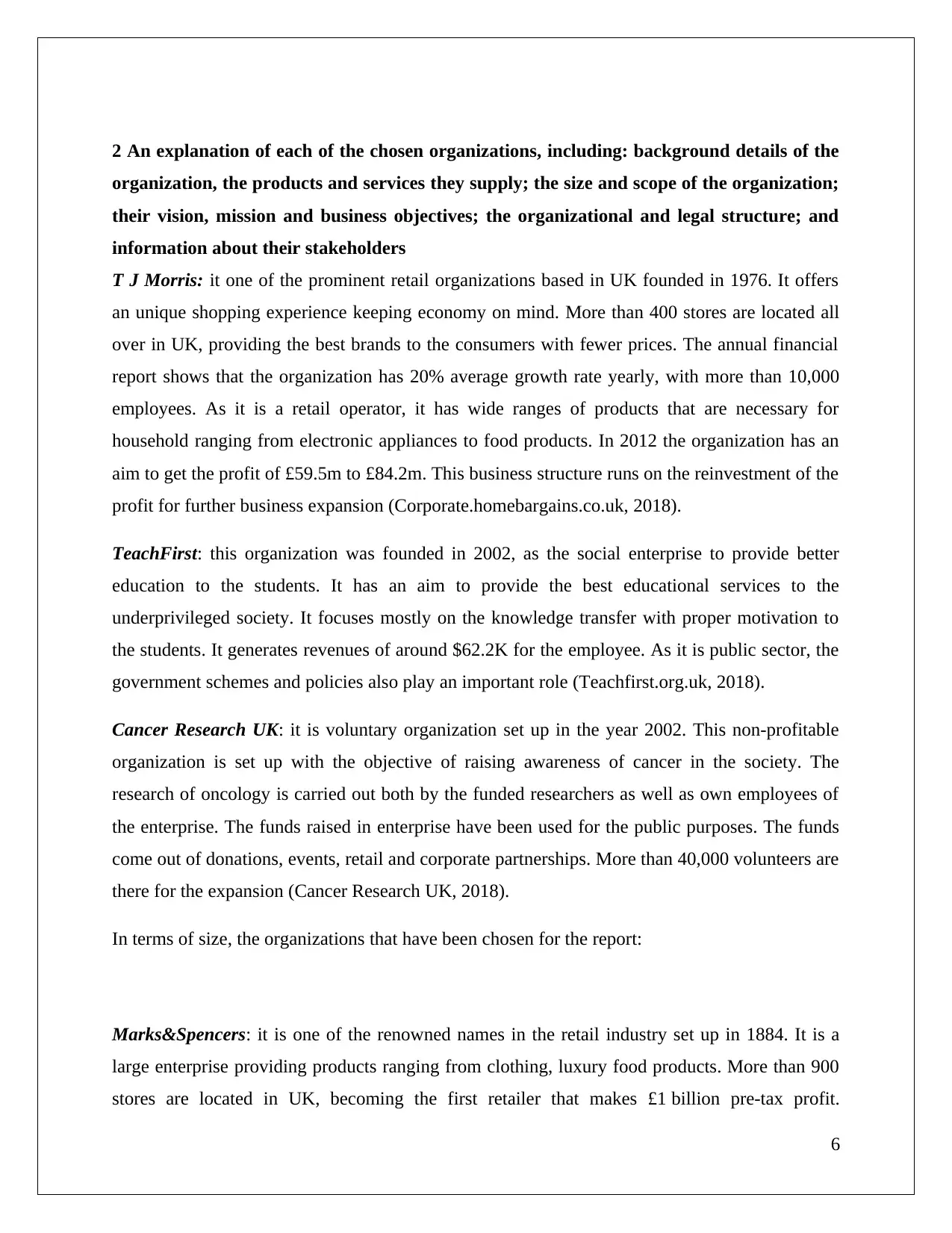
2 An explanation of each of the chosen organizations, including: background details of the
organization, the products and services they supply; the size and scope of the organization;
their vision, mission and business objectives; the organizational and legal structure; and
information about their stakeholders
T J Morris: it one of the prominent retail organizations based in UK founded in 1976. It offers
an unique shopping experience keeping economy on mind. More than 400 stores are located all
over in UK, providing the best brands to the consumers with fewer prices. The annual financial
report shows that the organization has 20% average growth rate yearly, with more than 10,000
employees. As it is a retail operator, it has wide ranges of products that are necessary for
household ranging from electronic appliances to food products. In 2012 the organization has an
aim to get the profit of £59.5m to £84.2m. This business structure runs on the reinvestment of the
profit for further business expansion (Corporate.homebargains.co.uk, 2018).
TeachFirst: this organization was founded in 2002, as the social enterprise to provide better
education to the students. It has an aim to provide the best educational services to the
underprivileged society. It focuses mostly on the knowledge transfer with proper motivation to
the students. It generates revenues of around $62.2K for the employee. As it is public sector, the
government schemes and policies also play an important role (Teachfirst.org.uk, 2018).
Cancer Research UK: it is voluntary organization set up in the year 2002. This non-profitable
organization is set up with the objective of raising awareness of cancer in the society. The
research of oncology is carried out both by the funded researchers as well as own employees of
the enterprise. The funds raised in enterprise have been used for the public purposes. The funds
come out of donations, events, retail and corporate partnerships. More than 40,000 volunteers are
there for the expansion (Cancer Research UK, 2018).
In terms of size, the organizations that have been chosen for the report:
Marks&Spencers: it is one of the renowned names in the retail industry set up in 1884. It is a
large enterprise providing products ranging from clothing, luxury food products. More than 900
stores are located in UK, becoming the first retailer that makes £1 billion pre-tax profit.
6
organization, the products and services they supply; the size and scope of the organization;
their vision, mission and business objectives; the organizational and legal structure; and
information about their stakeholders
T J Morris: it one of the prominent retail organizations based in UK founded in 1976. It offers
an unique shopping experience keeping economy on mind. More than 400 stores are located all
over in UK, providing the best brands to the consumers with fewer prices. The annual financial
report shows that the organization has 20% average growth rate yearly, with more than 10,000
employees. As it is a retail operator, it has wide ranges of products that are necessary for
household ranging from electronic appliances to food products. In 2012 the organization has an
aim to get the profit of £59.5m to £84.2m. This business structure runs on the reinvestment of the
profit for further business expansion (Corporate.homebargains.co.uk, 2018).
TeachFirst: this organization was founded in 2002, as the social enterprise to provide better
education to the students. It has an aim to provide the best educational services to the
underprivileged society. It focuses mostly on the knowledge transfer with proper motivation to
the students. It generates revenues of around $62.2K for the employee. As it is public sector, the
government schemes and policies also play an important role (Teachfirst.org.uk, 2018).
Cancer Research UK: it is voluntary organization set up in the year 2002. This non-profitable
organization is set up with the objective of raising awareness of cancer in the society. The
research of oncology is carried out both by the funded researchers as well as own employees of
the enterprise. The funds raised in enterprise have been used for the public purposes. The funds
come out of donations, events, retail and corporate partnerships. More than 40,000 volunteers are
there for the expansion (Cancer Research UK, 2018).
In terms of size, the organizations that have been chosen for the report:
Marks&Spencers: it is one of the renowned names in the retail industry set up in 1884. It is a
large enterprise providing products ranging from clothing, luxury food products. More than 900
stores are located in UK, becoming the first retailer that makes £1 billion pre-tax profit.
6
⊘ This is a preview!⊘
Do you want full access?
Subscribe today to unlock all pages.

Trusted by 1+ million students worldwide
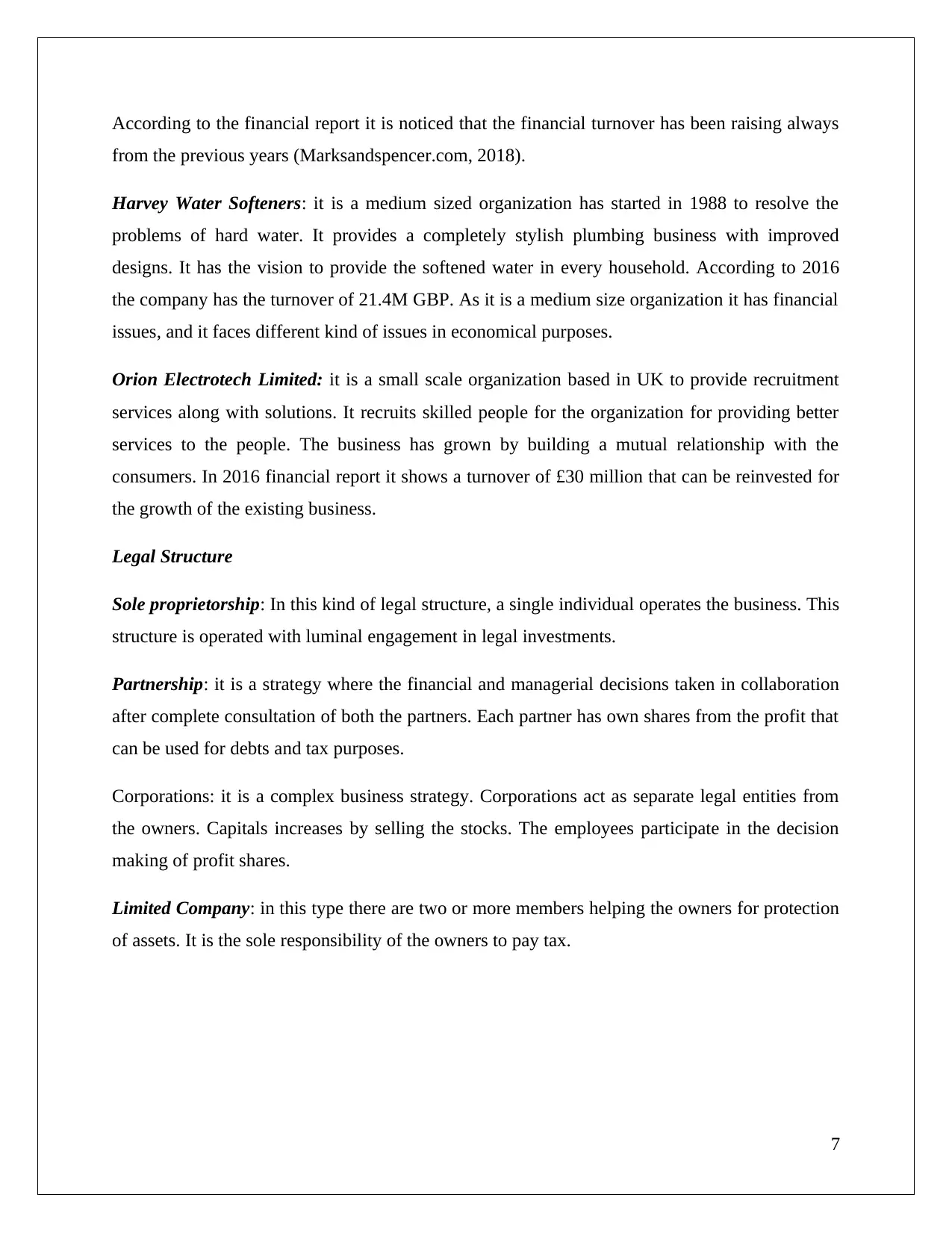
According to the financial report it is noticed that the financial turnover has been raising always
from the previous years (Marksandspencer.com, 2018).
Harvey Water Softeners: it is a medium sized organization has started in 1988 to resolve the
problems of hard water. It provides a completely stylish plumbing business with improved
designs. It has the vision to provide the softened water in every household. According to 2016
the company has the turnover of 21.4M GBP. As it is a medium size organization it has financial
issues, and it faces different kind of issues in economical purposes.
Orion Electrotech Limited: it is a small scale organization based in UK to provide recruitment
services along with solutions. It recruits skilled people for the organization for providing better
services to the people. The business has grown by building a mutual relationship with the
consumers. In 2016 financial report it shows a turnover of £30 million that can be reinvested for
the growth of the existing business.
Legal Structure
Sole proprietorship: In this kind of legal structure, a single individual operates the business. This
structure is operated with luminal engagement in legal investments.
Partnership: it is a strategy where the financial and managerial decisions taken in collaboration
after complete consultation of both the partners. Each partner has own shares from the profit that
can be used for debts and tax purposes.
Corporations: it is a complex business strategy. Corporations act as separate legal entities from
the owners. Capitals increases by selling the stocks. The employees participate in the decision
making of profit shares.
Limited Company: in this type there are two or more members helping the owners for protection
of assets. It is the sole responsibility of the owners to pay tax.
7
from the previous years (Marksandspencer.com, 2018).
Harvey Water Softeners: it is a medium sized organization has started in 1988 to resolve the
problems of hard water. It provides a completely stylish plumbing business with improved
designs. It has the vision to provide the softened water in every household. According to 2016
the company has the turnover of 21.4M GBP. As it is a medium size organization it has financial
issues, and it faces different kind of issues in economical purposes.
Orion Electrotech Limited: it is a small scale organization based in UK to provide recruitment
services along with solutions. It recruits skilled people for the organization for providing better
services to the people. The business has grown by building a mutual relationship with the
consumers. In 2016 financial report it shows a turnover of £30 million that can be reinvested for
the growth of the existing business.
Legal Structure
Sole proprietorship: In this kind of legal structure, a single individual operates the business. This
structure is operated with luminal engagement in legal investments.
Partnership: it is a strategy where the financial and managerial decisions taken in collaboration
after complete consultation of both the partners. Each partner has own shares from the profit that
can be used for debts and tax purposes.
Corporations: it is a complex business strategy. Corporations act as separate legal entities from
the owners. Capitals increases by selling the stocks. The employees participate in the decision
making of profit shares.
Limited Company: in this type there are two or more members helping the owners for protection
of assets. It is the sole responsibility of the owners to pay tax.
7
Paraphrase This Document
Need a fresh take? Get an instant paraphrase of this document with our AI Paraphraser
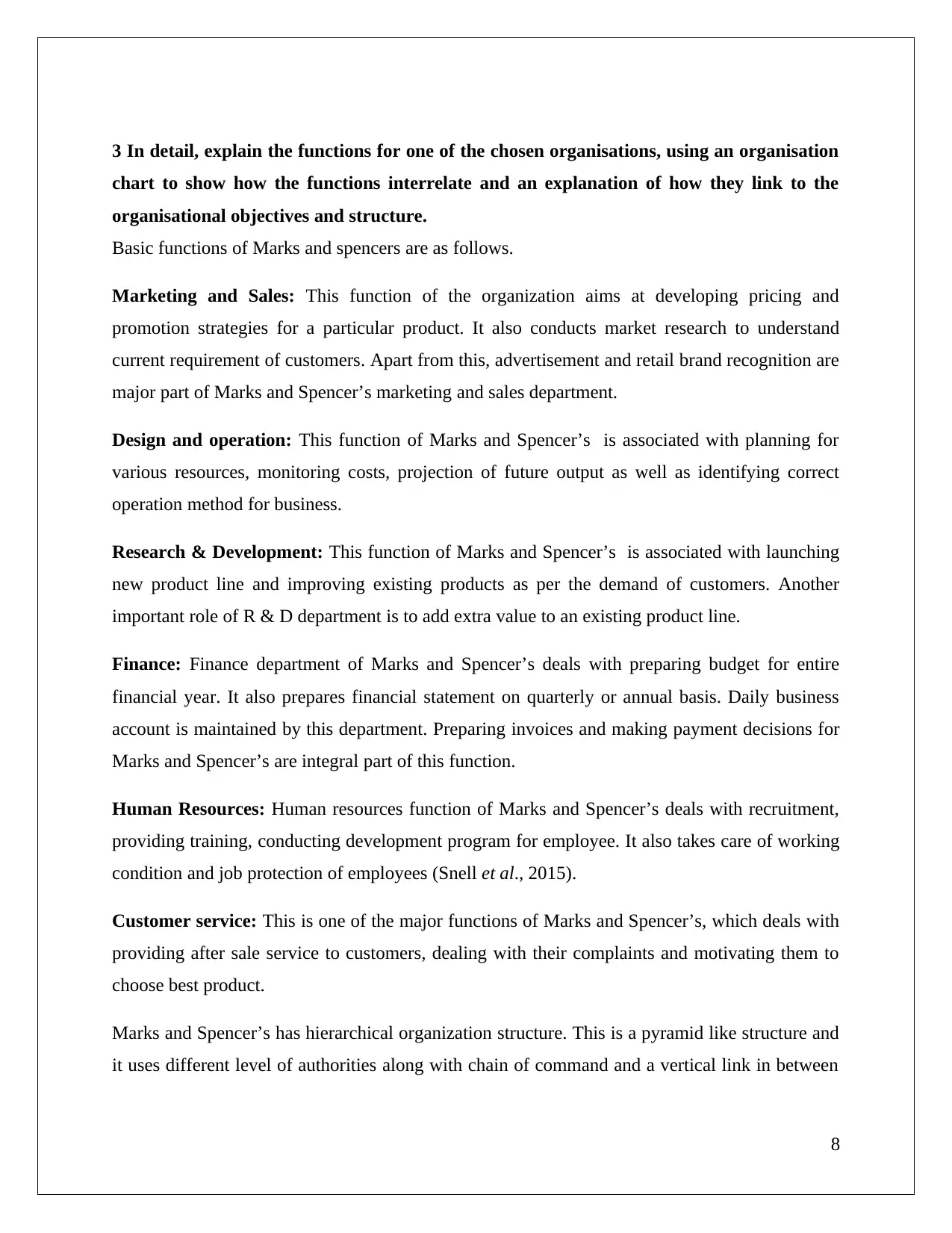
3 In detail, explain the functions for one of the chosen organisations, using an organisation
chart to show how the functions interrelate and an explanation of how they link to the
organisational objectives and structure.
Basic functions of Marks and spencers are as follows.
Marketing and Sales: This function of the organization aims at developing pricing and
promotion strategies for a particular product. It also conducts market research to understand
current requirement of customers. Apart from this, advertisement and retail brand recognition are
major part of Marks and Spencer’s marketing and sales department.
Design and operation: This function of Marks and Spencer’s is associated with planning for
various resources, monitoring costs, projection of future output as well as identifying correct
operation method for business.
Research & Development: This function of Marks and Spencer’s is associated with launching
new product line and improving existing products as per the demand of customers. Another
important role of R & D department is to add extra value to an existing product line.
Finance: Finance department of Marks and Spencer’s deals with preparing budget for entire
financial year. It also prepares financial statement on quarterly or annual basis. Daily business
account is maintained by this department. Preparing invoices and making payment decisions for
Marks and Spencer’s are integral part of this function.
Human Resources: Human resources function of Marks and Spencer’s deals with recruitment,
providing training, conducting development program for employee. It also takes care of working
condition and job protection of employees (Snell et al., 2015).
Customer service: This is one of the major functions of Marks and Spencer’s, which deals with
providing after sale service to customers, dealing with their complaints and motivating them to
choose best product.
Marks and Spencer’s has hierarchical organization structure. This is a pyramid like structure and
it uses different level of authorities along with chain of command and a vertical link in between
8
chart to show how the functions interrelate and an explanation of how they link to the
organisational objectives and structure.
Basic functions of Marks and spencers are as follows.
Marketing and Sales: This function of the organization aims at developing pricing and
promotion strategies for a particular product. It also conducts market research to understand
current requirement of customers. Apart from this, advertisement and retail brand recognition are
major part of Marks and Spencer’s marketing and sales department.
Design and operation: This function of Marks and Spencer’s is associated with planning for
various resources, monitoring costs, projection of future output as well as identifying correct
operation method for business.
Research & Development: This function of Marks and Spencer’s is associated with launching
new product line and improving existing products as per the demand of customers. Another
important role of R & D department is to add extra value to an existing product line.
Finance: Finance department of Marks and Spencer’s deals with preparing budget for entire
financial year. It also prepares financial statement on quarterly or annual basis. Daily business
account is maintained by this department. Preparing invoices and making payment decisions for
Marks and Spencer’s are integral part of this function.
Human Resources: Human resources function of Marks and Spencer’s deals with recruitment,
providing training, conducting development program for employee. It also takes care of working
condition and job protection of employees (Snell et al., 2015).
Customer service: This is one of the major functions of Marks and Spencer’s, which deals with
providing after sale service to customers, dealing with their complaints and motivating them to
choose best product.
Marks and Spencer’s has hierarchical organization structure. This is a pyramid like structure and
it uses different level of authorities along with chain of command and a vertical link in between
8
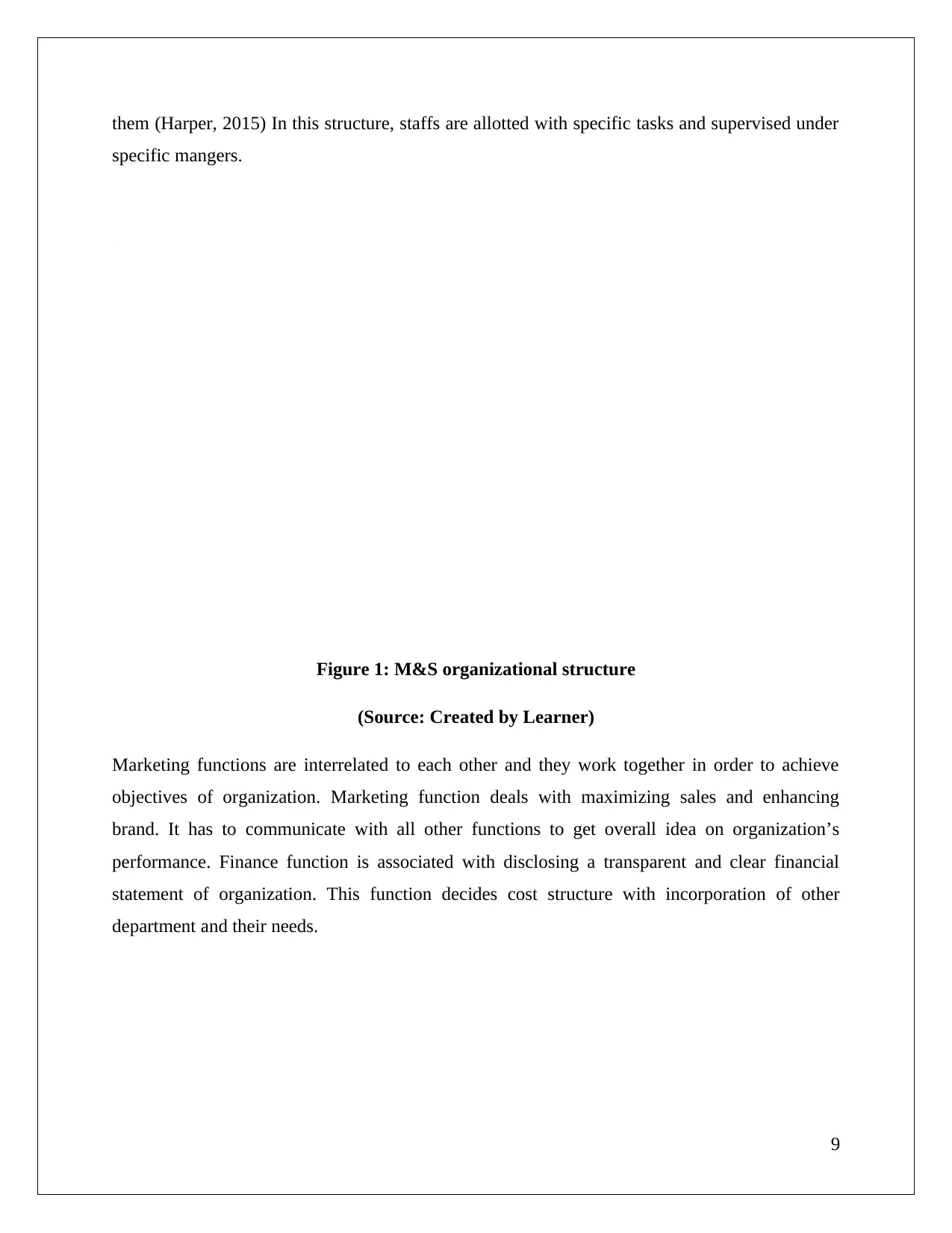
them (Harper, 2015) In this structure, staffs are allotted with specific tasks and supervised under
specific mangers.
Figure 1: M&S organizational structure
(Source: Created by Learner)
Marketing functions are interrelated to each other and they work together in order to achieve
objectives of organization. Marketing function deals with maximizing sales and enhancing
brand. It has to communicate with all other functions to get overall idea on organization’s
performance. Finance function is associated with disclosing a transparent and clear financial
statement of organization. This function decides cost structure with incorporation of other
department and their needs.
9
PresidentOperationManager1Manager2R&DManager1Manager2MarketingManager1Manager2HRManager1Manager2FinanceManager1Manager2
specific mangers.
Figure 1: M&S organizational structure
(Source: Created by Learner)
Marketing functions are interrelated to each other and they work together in order to achieve
objectives of organization. Marketing function deals with maximizing sales and enhancing
brand. It has to communicate with all other functions to get overall idea on organization’s
performance. Finance function is associated with disclosing a transparent and clear financial
statement of organization. This function decides cost structure with incorporation of other
department and their needs.
9
PresidentOperationManager1Manager2R&DManager1Manager2MarketingManager1Manager2HRManager1Manager2FinanceManager1Manager2
⊘ This is a preview!⊘
Do you want full access?
Subscribe today to unlock all pages.

Trusted by 1+ million students worldwide
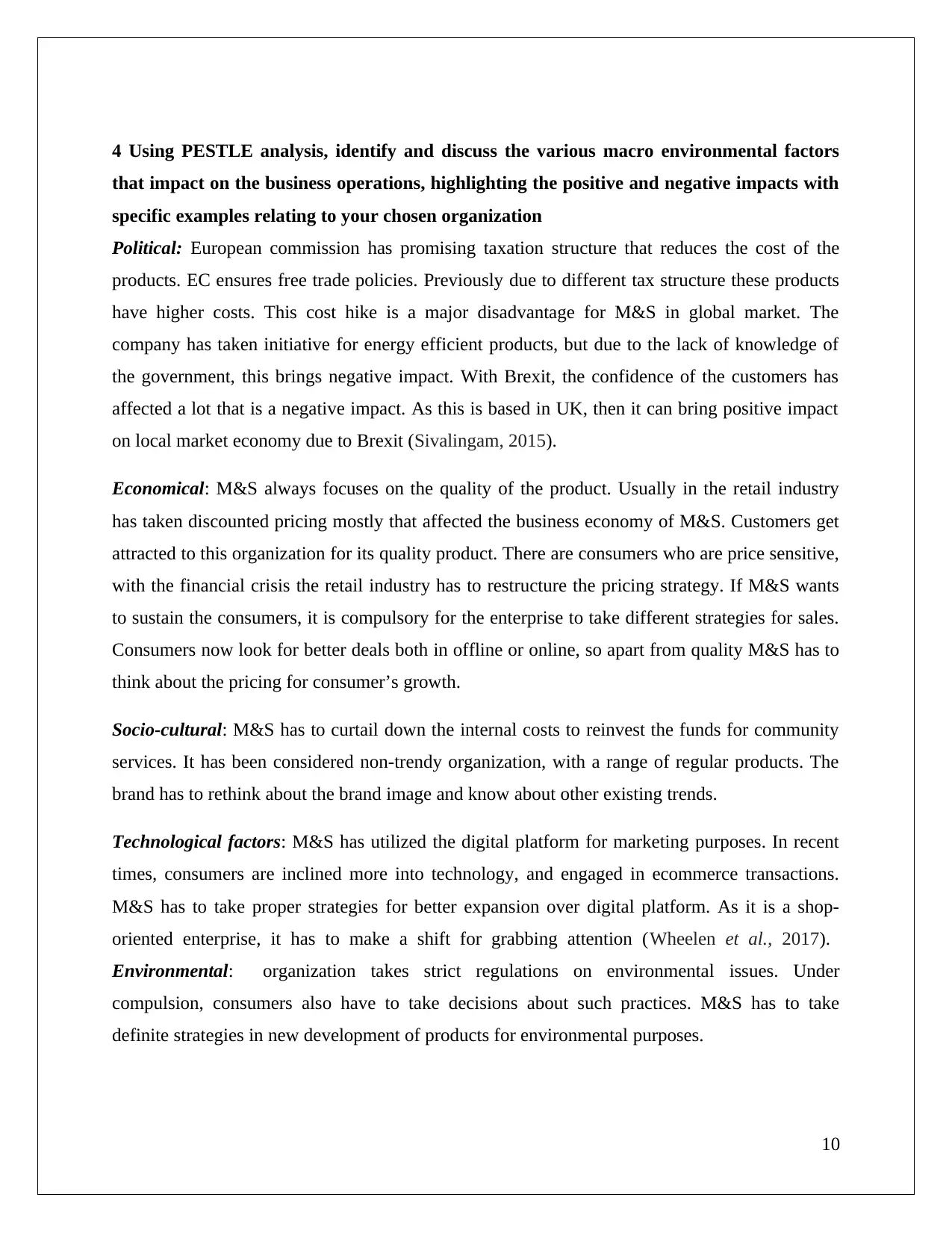
4 Using PESTLE analysis, identify and discuss the various macro environmental factors
that impact on the business operations, highlighting the positive and negative impacts with
specific examples relating to your chosen organization
Political: European commission has promising taxation structure that reduces the cost of the
products. EC ensures free trade policies. Previously due to different tax structure these products
have higher costs. This cost hike is a major disadvantage for M&S in global market. The
company has taken initiative for energy efficient products, but due to the lack of knowledge of
the government, this brings negative impact. With Brexit, the confidence of the customers has
affected a lot that is a negative impact. As this is based in UK, then it can bring positive impact
on local market economy due to Brexit (Sivalingam, 2015).
Economical: M&S always focuses on the quality of the product. Usually in the retail industry
has taken discounted pricing mostly that affected the business economy of M&S. Customers get
attracted to this organization for its quality product. There are consumers who are price sensitive,
with the financial crisis the retail industry has to restructure the pricing strategy. If M&S wants
to sustain the consumers, it is compulsory for the enterprise to take different strategies for sales.
Consumers now look for better deals both in offline or online, so apart from quality M&S has to
think about the pricing for consumer’s growth.
Socio-cultural: M&S has to curtail down the internal costs to reinvest the funds for community
services. It has been considered non-trendy organization, with a range of regular products. The
brand has to rethink about the brand image and know about other existing trends.
Technological factors: M&S has utilized the digital platform for marketing purposes. In recent
times, consumers are inclined more into technology, and engaged in ecommerce transactions.
M&S has to take proper strategies for better expansion over digital platform. As it is a shop-
oriented enterprise, it has to make a shift for grabbing attention (Wheelen et al., 2017).
Environmental: organization takes strict regulations on environmental issues. Under
compulsion, consumers also have to take decisions about such practices. M&S has to take
definite strategies in new development of products for environmental purposes.
10
that impact on the business operations, highlighting the positive and negative impacts with
specific examples relating to your chosen organization
Political: European commission has promising taxation structure that reduces the cost of the
products. EC ensures free trade policies. Previously due to different tax structure these products
have higher costs. This cost hike is a major disadvantage for M&S in global market. The
company has taken initiative for energy efficient products, but due to the lack of knowledge of
the government, this brings negative impact. With Brexit, the confidence of the customers has
affected a lot that is a negative impact. As this is based in UK, then it can bring positive impact
on local market economy due to Brexit (Sivalingam, 2015).
Economical: M&S always focuses on the quality of the product. Usually in the retail industry
has taken discounted pricing mostly that affected the business economy of M&S. Customers get
attracted to this organization for its quality product. There are consumers who are price sensitive,
with the financial crisis the retail industry has to restructure the pricing strategy. If M&S wants
to sustain the consumers, it is compulsory for the enterprise to take different strategies for sales.
Consumers now look for better deals both in offline or online, so apart from quality M&S has to
think about the pricing for consumer’s growth.
Socio-cultural: M&S has to curtail down the internal costs to reinvest the funds for community
services. It has been considered non-trendy organization, with a range of regular products. The
brand has to rethink about the brand image and know about other existing trends.
Technological factors: M&S has utilized the digital platform for marketing purposes. In recent
times, consumers are inclined more into technology, and engaged in ecommerce transactions.
M&S has to take proper strategies for better expansion over digital platform. As it is a shop-
oriented enterprise, it has to make a shift for grabbing attention (Wheelen et al., 2017).
Environmental: organization takes strict regulations on environmental issues. Under
compulsion, consumers also have to take decisions about such practices. M&S has to take
definite strategies in new development of products for environmental purposes.
10
Paraphrase This Document
Need a fresh take? Get an instant paraphrase of this document with our AI Paraphraser
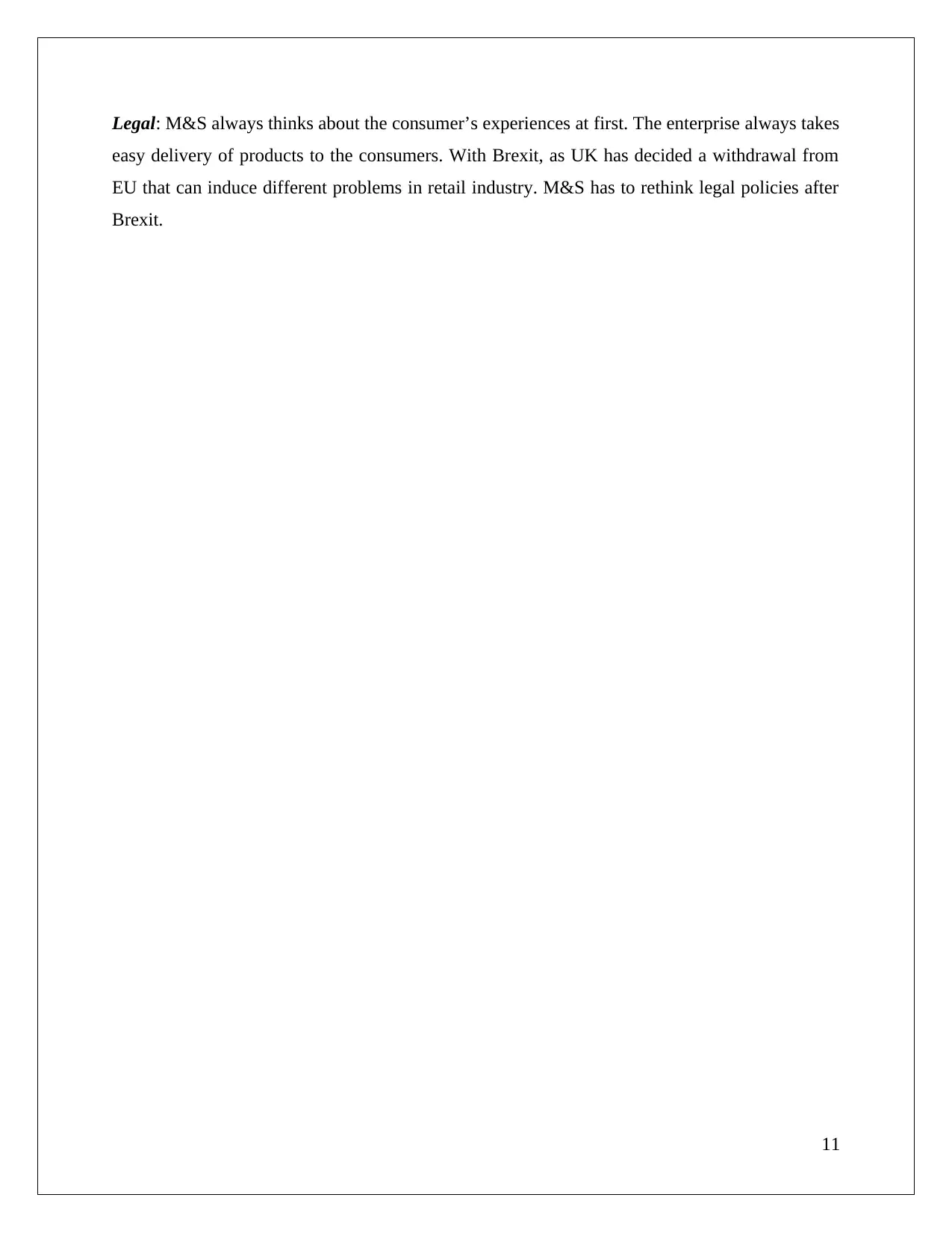
Legal: M&S always thinks about the consumer’s experiences at first. The enterprise always takes
easy delivery of products to the consumers. With Brexit, as UK has decided a withdrawal from
EU that can induce different problems in retail industry. M&S has to rethink legal policies after
Brexit.
11
easy delivery of products to the consumers. With Brexit, as UK has decided a withdrawal from
EU that can induce different problems in retail industry. M&S has to rethink legal policies after
Brexit.
11

5 Conduct the internal and external analysis for the chosen organization in order to
identify the strengths and weakness. Explain how they influence the decision-making
process.
The success of any esteemed organization depends on different internal as well as external
factors. In this section it is explained how SWOT analysis affects decision-making process of an
organization.
Strengths
As it is a huge name in retail industry in
UK, the brand image of this
organization plays an important role for
grabbing attention of the consumers
Wide varieties of products for the
consumers to choose
For last 40 years the organization has
started selling vegetables that are
considered to be organic
Small farmers supply the fresh products
to the organization. This shows how the
organization aims to supply the best
products to the consumers
M&S conducts a wide range of testing
of the products before supplying such
products to the consumers. It does not
compromise with the quality of the
products (Badii et al., 2018)
More than 500 food suppliers send
fresh products like vegetables, salads,
fruits to the distributors, as other
competitors can never produce such
fresh quality products
It has more than 500 stores in UK, this
shows the annual turnover of the
enterprise has constantly increased
As it is a distributor of other brands, so
a consumer can easily get all the
products and commodities under a
single roof
Weakness
It has a major drawback due to negative
publicity for non-trendy products
As it is the distributor of different
branded products for all ages, the
consumer gets wrong idea about the
products
It is affecting the business culture of the
organization
It does not produce products mostly for
the youngsters. For that market
segment, this retailer has to take
innovative strategies
It has committed consumers, for the last
few years it has not added new
customers. It has failed to identify with
the requirements of the younger
generation
It has a bad reputation that it makes
products for the people of elderly
people, and it has to give strong
competition to other well known
retailers (Jain, 2015)
It does not want to incorporate new
technologies. It continues in
implementing old techniques.
New technologies always help the
organization to manage with time,
money. But M&S has failed to accept
such changes
It is still dependent on manual power
for committing any kind of work, this
little time consuming as well as
expensive
Due to the manual work it cannot
engage in better business structure
Opportunities Threats
12
identify the strengths and weakness. Explain how they influence the decision-making
process.
The success of any esteemed organization depends on different internal as well as external
factors. In this section it is explained how SWOT analysis affects decision-making process of an
organization.
Strengths
As it is a huge name in retail industry in
UK, the brand image of this
organization plays an important role for
grabbing attention of the consumers
Wide varieties of products for the
consumers to choose
For last 40 years the organization has
started selling vegetables that are
considered to be organic
Small farmers supply the fresh products
to the organization. This shows how the
organization aims to supply the best
products to the consumers
M&S conducts a wide range of testing
of the products before supplying such
products to the consumers. It does not
compromise with the quality of the
products (Badii et al., 2018)
More than 500 food suppliers send
fresh products like vegetables, salads,
fruits to the distributors, as other
competitors can never produce such
fresh quality products
It has more than 500 stores in UK, this
shows the annual turnover of the
enterprise has constantly increased
As it is a distributor of other brands, so
a consumer can easily get all the
products and commodities under a
single roof
Weakness
It has a major drawback due to negative
publicity for non-trendy products
As it is the distributor of different
branded products for all ages, the
consumer gets wrong idea about the
products
It is affecting the business culture of the
organization
It does not produce products mostly for
the youngsters. For that market
segment, this retailer has to take
innovative strategies
It has committed consumers, for the last
few years it has not added new
customers. It has failed to identify with
the requirements of the younger
generation
It has a bad reputation that it makes
products for the people of elderly
people, and it has to give strong
competition to other well known
retailers (Jain, 2015)
It does not want to incorporate new
technologies. It continues in
implementing old techniques.
New technologies always help the
organization to manage with time,
money. But M&S has failed to accept
such changes
It is still dependent on manual power
for committing any kind of work, this
little time consuming as well as
expensive
Due to the manual work it cannot
engage in better business structure
Opportunities Threats
12
⊘ This is a preview!⊘
Do you want full access?
Subscribe today to unlock all pages.

Trusted by 1+ million students worldwide
1 out of 18
Related Documents
Your All-in-One AI-Powered Toolkit for Academic Success.
+13062052269
info@desklib.com
Available 24*7 on WhatsApp / Email
![[object Object]](/_next/static/media/star-bottom.7253800d.svg)
Unlock your academic potential
Copyright © 2020–2025 A2Z Services. All Rights Reserved. Developed and managed by ZUCOL.

